The insight of Francine Houben to city, architecture and living can be seen in the design of winning works and Q&A of final review. At the same time, the host and planner will discuss the design inspired by each work from the viewpoint of Taiwan practitioners to help the public to understand the idea of the 8 winning works and its inspiration for housing architecture and design.

Host and editor
Wang, Chin-Kun/TRAA Secrectary Genera
Chang, Chi-Sey/Sun-Yuan Architects & Associate Senior Manager
Attendees
Huang, Chang-Mei/Taiwan Architecture Magazine chief editor
Chen, Chung-Heng/Sun-Yuan Architects & Associate Host Architect
Hsu, I-Ming/Sun-Yuan Architects & Associate Host Architect
Chung, Chiu-Ju/Sun-Yuan Architects & Associate Host Architect
First prize-Ghost to Host/Pongpol Puangniyom+Mah Yi Jun
Project Web:https://reurl.cc/L0Y9v7
Huang: The idea of “vertical street” is used to rebuild abandoned building - Sathon Unique, which also responses to Francine’s declaration in the competition by its concept of forward-looking, sustainability and practicability. The “vertical street” idea can connect public spaces to take care families with different demands and can lockdown the building to become a self-sufficient environment through space distribution based on levels of publicity. The design of ventilation, daylight and public space is flexible and the idea presents the concept of connection and abundant layout and design. Both should be the important reasons the work is selected.
Chen: I think the team brings up an unpredictable and new design toward the “abandoned building” which is like an architecture tumor in a city. A 2-kilometer road is designed in the building which can create public and private spaces and all of social demands. The idea is to pay attention to abandoned buildings which affect the landscape of cities during the period of COVID-19. The idea also inspires countries to think about solutions for abandoned buildings.
Hsu: The idea of vertical street surrounding the building can change an uninteresting appearance of building to vidid by solid and void arrangement. The idea also can create open and semi-open spaces to allocate various spaces and meet self-sufficient demand. However, the team does not give the solution to solve the problem of outbreak of Covid-19 by the idea.
Chung: “Pandemic prevention” is a problem of science. The competition inspires different viewpoints to solve the problem in a practical, more open or declarative way. The work shows a great presentation whatever the topic or layout. The team images the design with an allegorical way instead of theory or evidence. They strongly elaborate the viewpoint of Covid-19 and focus on how to rebuild the abandoned building by design. If we peruse the design, we still can find their design echoes Covid-19 issue.
Chang: The layout and idea of the work is good. It is impossible for people to walk along a 2-kilometer vertical road in reality. However, the important point of the competition is to inspire us to imagine all possibilities. The team makes it.

Second prize-Extension of Living/Huang Zih Jhe
Project Web:https://reurl.cc/9ZMggx
Hsu: Layout of the work is in detail. The design elaborates the unit of housing space, enough distance between blocks, space for light and wind and increase of public space ratio. The function of housing is concentrated in the middle of the layout and reserves surrounding space as void for flexible use to respond to Covid-19 issues. The idea can provide a comfortable living environment when people are isolated at home and become a vivid appearance of building. However, the design will build a level of “luxury house” which is a little gap from the affordable housing Fancine expected.
Chen: The design clearly responds to the pandemic and points out the direction of future development of housing design. “Balcony” is modified to become the exit for residents (people isolated) and living boundary is enlarged for residents to change flexibly. Transparent and opaque materials are used for open and private space due to the private concern. A platform is used to connect door and door, which will become a large outdoor space when the community has to be lockdown during the outbreak of pandemic.
Chung: Because the designer’s background of living is similar to us, the idea of work could be easier to implement and understand for us. This is also a two-face question. One way is that the design can easier to inspire Taiwanese designers and in contrast to the first prize the design would be less stunning. The core of concept is “pull away” which pulls away the medium space to prevent pandemic. It is a firm and steady strategy but lacking of strong and declarative intention.
Huang: The ideality, feasibility, internationality and locality all can all be seen in the work. The design of multiple functions of public balcony, sociability and interactivity is impressive. However, the design level needs to be improved and the idea may fix the problem of remodeling old buildings better than be used in new projects.
Wang: The feasibility of the work is high if the laws and regulations are not taken into account. The most difficult situation is to let users can accept the void spaces. The original concept will go wrong because balconies are often combined as outdoor space in Taiwan.
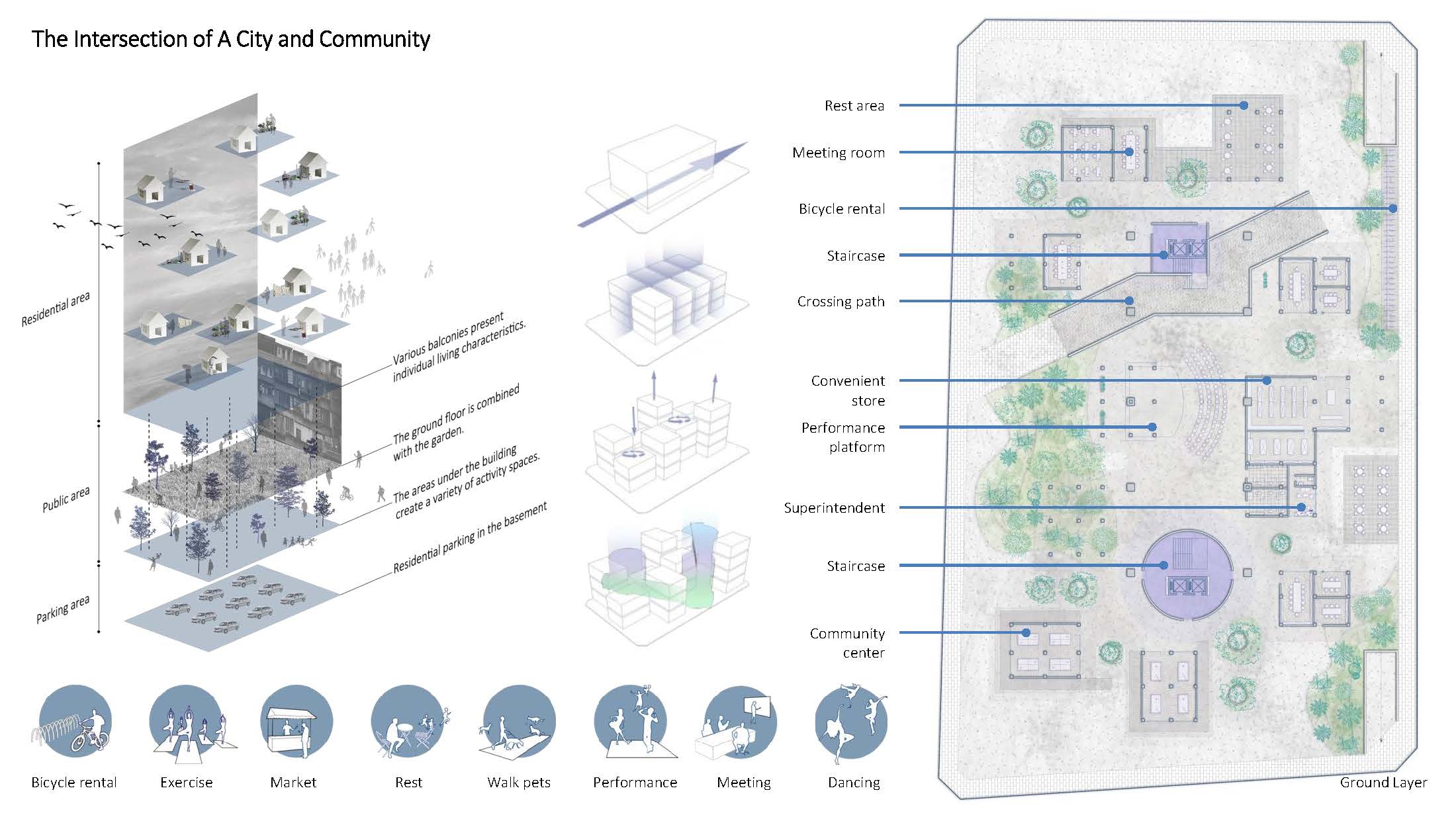
Third prize-RECONFIGURING NYC/Marco Moccia、Chen Ken
Project Web:https://reurl.cc/nnkW8d
Chen: The team tries to create a mixed community. Public spaces can be connected by corridors which can be used for interaction, solving the Covid-19 issue and separating public and private spaces as well. The spaces from ground to roof can be open flexibly to adapt demand of families and the circulation of light and wind.
Chung: The design is pragmatic but the intention and touching feeling is weaker than the first and second prize. The idea of “negative space” is to echo to the topic of competition. Various layouts of corridors, public spaces and roof terrace and excavations among the building can be seen to show the relationship between solid and void. However, the concept of the design is weaker and fewer connection with the topic of competition.
Hsu: Floors are stacked up from one corner to diagonal direction to become a high building. Two large courtyards create a public space where air and light can penetrate. Although the design connects the building and surrounding environment friendly, we could not see an unique concept toward the Covid-19 issue.
Huang: Layout is not so special in the design. The point is that continuous roof terraces and excavated volume both make up a public space which allows ventilation to respond to the Covid-19 issue without air conditions. However, there is no further expression regarding to traffic connection of each floor and layout of housing units. There is no connection between roof terrace and indoor space.
Chang: There is nothing new in the design as being a work in the competition. Judge Francine chooses the work as the third prize according to her experience of continually paying attention to publicity and social housing. Her background of education in Netherlands is also to educate her to respect individual rights and practically face various problems. I think that Francine and her team positively agree the practical solutions raised by participants. However, we also want to see more inspired and creative ideas in the competition. That is why the work goes to the third prize.

Special mentioned-Gap: Disconnect to Connect/Chai Yi Yang、Ng Yi Ming、Bong Wei Jian
Project Web:https://reurl.cc/Gd7MbW
Huang: The concept of “Snakes and Ladders” is used in the work to present the atmosphere of an amusement park. However, the idea may create a place for short-term but not for a long-term accommodation.
Chang: There is only “concept” but no “space” in the design. The team divides volume of the building into small grids as the living units and other spaces left become the public spaces. We do not see further design in progress. It is pity that one of important works for architects is to handle the spaces.
Hsu: The idea is interesting that grids are used to dispose layout for families by modules. However, the biggest problem is the design for physical environment. Daylight comes from surrounding houses, both or three sides of the house. However, the space of middle houses is not adjacent to the boundary of construction leading to an uncomfortable living environment though there are still indirect daylight and wind coming.
Chen: Designers focus on the operation of game elements but the demand of body and mind of residents is missed. It is not enough for practical fulfillment but could be an acceptable idea for the competition.
Chung: The main role is “gap”, also the “connect”, if we check the title. However, the cube of so closed type is figured out comes from the concept of disconnect to respond to the Covid-19 issue. The team defines 4 kinds of family combination for users but the combination digresses the concept of disconnect. It confuses us that the idea is for a connection between uses or is for space design? Nevertheless, the concept of “Snakes and Ladders” is used to prevent pandemic is interesting.

Special mentioned-Housing Re-framed/Inka Eismar、Coll Drury、Jenna Imrie McMahon
Project Web:https://reurl.cc/4yE2av
Chen: Extension space is created to supplement demands of the community. The Cross-laminated timber (CLT) system is added around outer layers of the high-rise congregate housing to solve the problem of closed indoor space. The ground area is also expanded to create more spaces for interaction and consumption. However, the CLT system I take it with a grain of salt. CLT is still a new way of construction which also costs more than steel construction on building and maintenance. There are still lots of problems we need to solve to popularize it globally.
Huang: The concept and idea are mainstream nowadays. I also support the use of timbers for sustainability and protection of environment. However, the rationality and meaning of using CLT in a whole surrounding outer layer are not clear. Furthermore, the balance between more and less is appropriate according to the densely populated cities. Problems may not be solved when adding up more.
Hsu: Designers seriously carry out the concept of module. Two individual buildings are connected with CLT system to create a diversified integrity and a self-sufficient community to face the situation of lockdown during the Covid-19 period. Although CLT system is sustainable and warm, the issue of durability and safety is needed to be discussed.
Chang: The idea is similar with the strategy of Anne Lacaton and Jean Philippe Vassal, 2021 Pritzker Architecture Prize winners, to rebuild the social housing called Grand Parc Estate in Bordeaux, France. The timber system is used to create more spaces of balcony for more daylight and air to increase quality of living. The resources and time can also be saved in the demolishing and rebuilding process. The successful strategy in Europe may not be implemented in Taiwan which has different law and culture. However, We still can take it as a good lesson.
Chung: The relationship between the idea and pandemic prevention is not strong. It is only to add public spaces such as the product trading center or childcare space to solve the inconvenience caused by lockdown. The Covid-19 issue is not under fully consideration in the design.
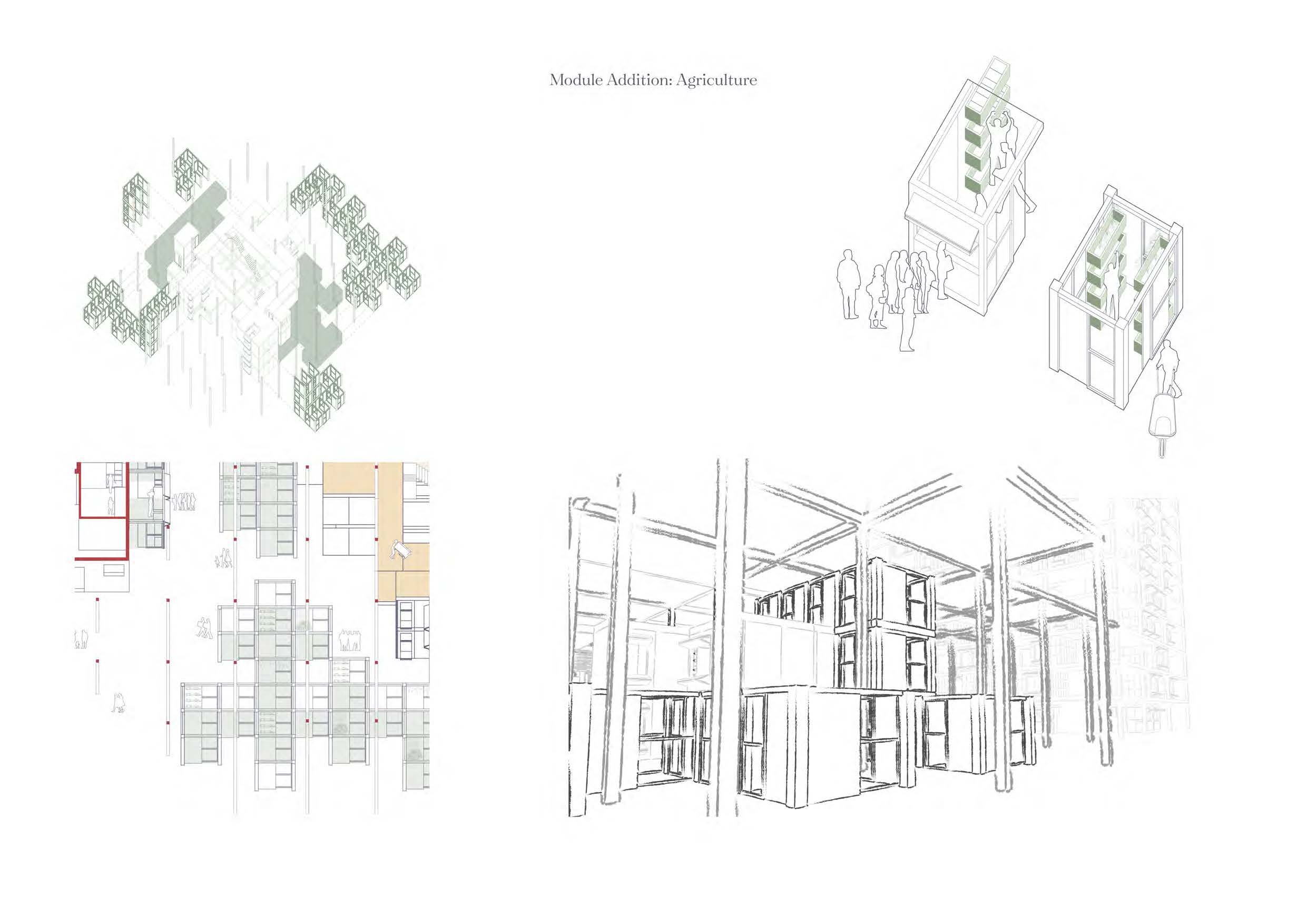
Special mentioned-Weather the epidemic in the community/Yin Jyun、Cao Yue Ning、Chen Sih Tong
Project Web:https://reurl.cc/NX3zXe
Hsu: The site of the work is similar with early apartments of community in Taiwan. The option of site is inspired for Taiwan. Designers connect 4 individual apartments by adding footbridges and public spaces to become an integrated and ingenious unit. However, how to add the extra building bulk to mee the construction law is needed to be discussed.
Chang: The team chooses a contemporary Chinese city as the site for the work and analyze resources elders and youngers have or not separately. The team tries to make the 2 generations to live together to complement resources and activate the old community. The team implements the concept into the design and adjusts the housing layout and traffic flows in and out. Extra corridors and vertical traffic flow provide youngers to have an individual entrance and create separated traffic flows to respond to the Covid-19 issue.
Huang: The aspect of consideration and expression for work is comprehensive, including the consideration of social tendency toward “pandemic” and “elders and youngers living together”. Extra corridors, vertical traffic flows and public spaces are designed and presented clearly to solve the change of space usage and traffic flows before, during and after the pandemic to create a self-sufficient community. The relationship between elders and youngers can also be matched by mobile phone software. All in all, it is a careful design. However, the design of architecture is not strong and the design of extra public spaces is still conceptual without quality.
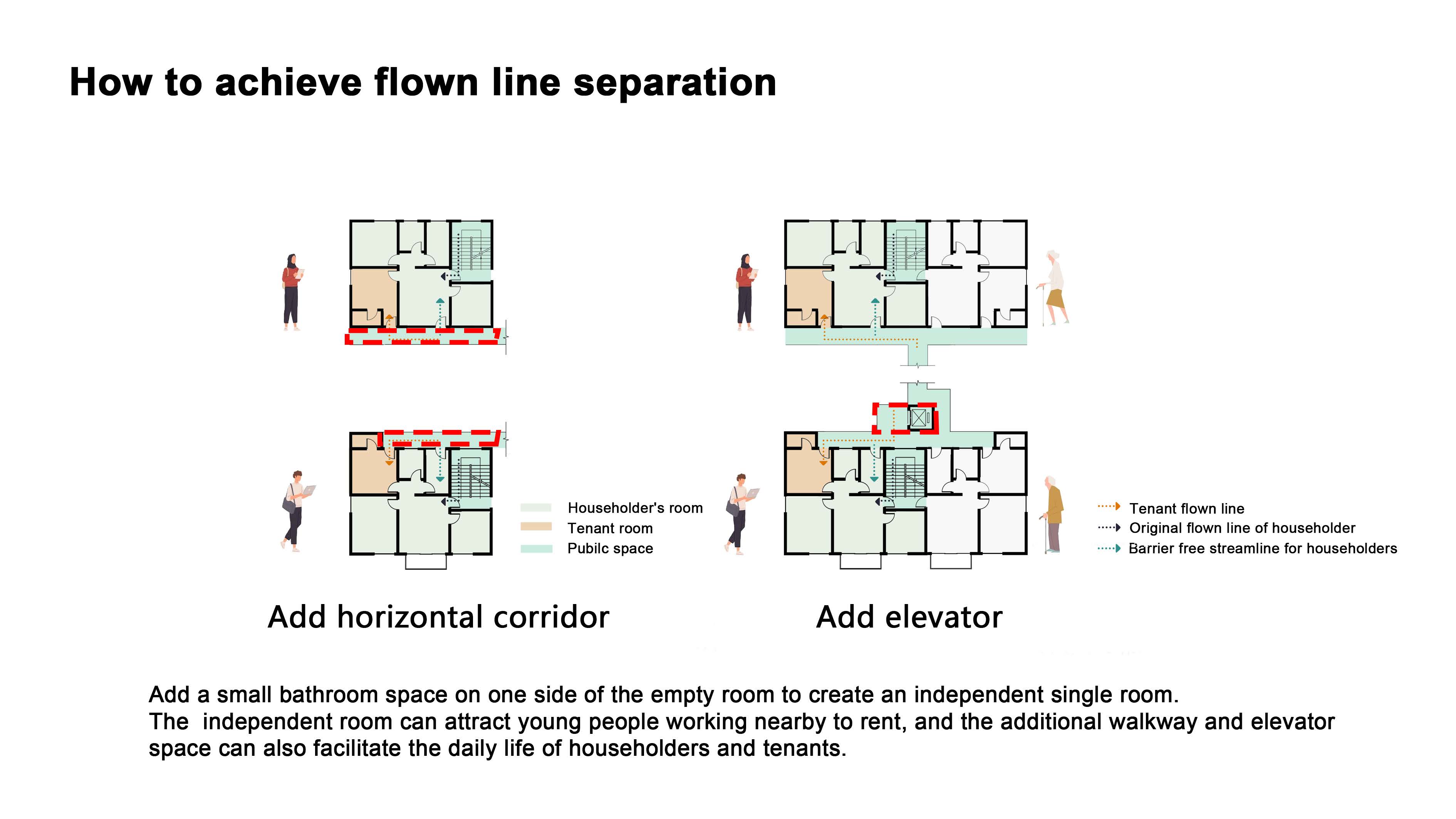
Participation Award-Iso Teract Pods/Wong Kai Yi、Low Xue Yee、Lim Pui San
Project Web:https://reurl.cc/V3KG6b
Huang: The concept of “Snakes and Ladders” is used in the work to present the atmosphere of an amusement park. However, the idea may create a place for short-term but not for a long-term accommodation.
Chen: The idea is full of imagination. The concept comes from the travel suitcase to try to solve original problems of living and prevent outbreak of pandemic. Bamboos are utilized to create more public spaces in the courtyard between 2 buildings. “Snakes and Ladders” is the concept to connect spaces and rearrange the layout. However, the idea somehow is interesting than practical condition of living and building.
Hsu: The site of the work is in Kuala Lumpur, Malaysia which is in a city for people of lower social class and immigrants. The idea is to fix original problems such as not enough number of windows and centralized vertical traffic flow by recycled bamboo to expand spaces to the courtyard to add more traffic flows. However, extra bamboo structure put in the narrow courtyard will lead middle and lower floors darker. Furthermore, many bamboos will be used as the strong structure to support so many spaces. We can see that there will be a huge gap between the plan and competition about daylight and circulation around spaces.
Chung: The level of drawing and presentation is high but it could be an over design. The title focuses on the living atmosphere but the presentation of layout is depressive. The disparity between both mentioned is huge.
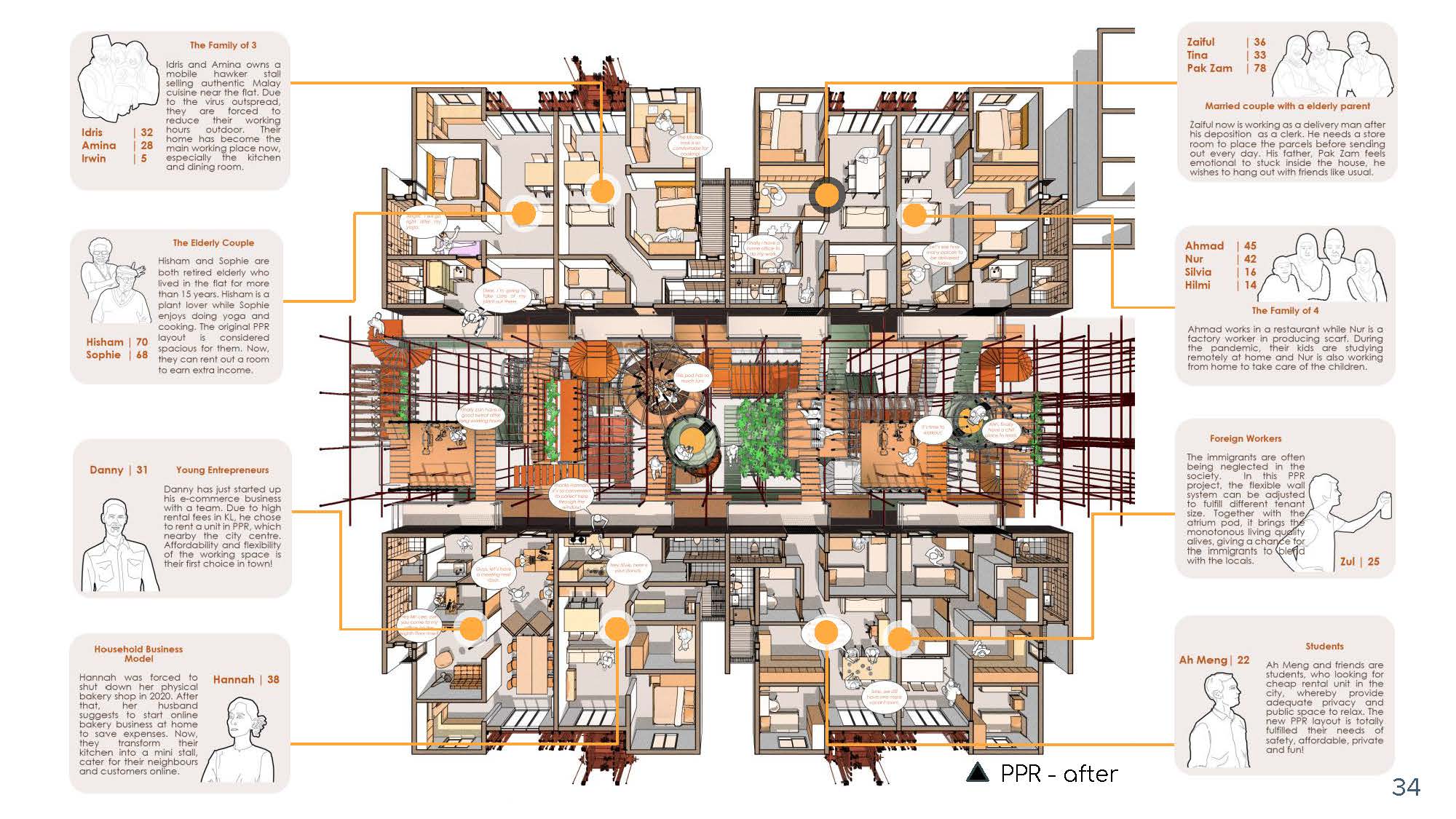
Participation Award-AirPods/Wong Ka Hei、Chan Yin Tat
Project Web:https://reurl.cc/dVRRdk
Chen: The team points out that one quarter of housing is illegal in Hong Kong which most of them are built on roof. Hence, the idea of capsule is used to provide living quality and solve the problem of illegal construction. The capsules can be built fast to provide a large amount of separated living spaces and solve the problem of insufficient land.
Huang: The presentation of layout is skillful and the idea is to emphasize the localization. The solution of handling the Covid-19 issue is missed as though the team raises the rationality and construction of capsule spaces. It is pity that only a way of reforming illegal constructions on roof can be seen.
Chung: The idea has been discussed by many scholars and architects in the 60s & 70s. The main concept is “removable “and “replaceable”, which is an idea for human beings. However, the higher cost of construction makes the idea unlikely to be done. Cheap and fast are reasons to build illegal constructions for people in general. The idea cannot meet the demand of market because of the expensive cost for construction, assembling and maintenance. The cost of mechatronic systems even has not been put in the capsule yet.
Hsu: The idea is to try to solve the problem of insufficient living spaces in Hong Kong. The work shows caring living environment where the team lives. Nevertheless, the root of the problem will still exist if the illegal things (illegal construction) solved by illegal measures. The team does not bring up a special solution for the pandemic but gives a clear expression for living. It could be seen from the plan focusing on single building to whole streets with capsules.

Conclusion
Add, Rebuild and New
The idea of half of winning works is to add or rebuild construction. It is definitely an eye-catching strategy and shows attention and as a contrast before and after. However, it is easier to implement the strategy in cities or countries with the problem of lacking enough land. It is more difficult to add or rebuild construction than demolish it. Often, it is not easy to convince every property owner to agree with the idea or it comes to a new demand for property owners to rebuild construction. For example, there are reasons for rebuilding construction such as high value of land, service facility complements (elevators), solution of construction safety and splitting construction cost with construction companies. It is the key to implement the idea as long as the reasons can be solved by the way in Taiwan.
The design mantra “Never demolish, never replace“ of Anne Lacato and Jean Philippe Vassal, 2021 Pritzker Architecture Prize winners, is an inspired declaration. However, client’s demand should be taken into consideration case by case in design actually. The measure of adding or rebuilding construction could be used if historical value of the original building is worthy to be deserved or having spare spaces in site. In addition, most of construction projects are hosted by construction companies in Taiwan, the measure of adding or rebuilding construction will definitely affect their business model. That is also a concern we need to deal with.
One of concepts in common of winners this year is to discuss the possibility of “mixed living”. Good solutions of mixed living situations for different kind of family combinations such as single, small and extended families; combinations of different income levels such as blue-and-white collar classes and combinations of different ages such as younger and elders are all raised in the concept. All of the situations can be handled in one community through the design of layout, public space arrangement, connection of traffic flow and utilization of mobile phone software without labeling residents. Also, a kind of new lifestyle is expected to be aroused among the diversified combinations and could complement demands for each other.
At the same time, all of teams create different public spaces and functions to respond to the demand of mixed living according to the concept. Ideas of urban farms, markets, handicraft studios, childcare institutions, coworking spaces and sharing kitchens are raised to meet the demand of different families and create spaces for interaction.

Test of new construction
The concept of environment protection, sustainability and reducing resources is in common around the world. Winning works present the way of adding or rebuilding housing instead of demolishment. Meanwhile, solutions for construction materials and structure such as choosing natural materials of timber (CLT) and bamboo to create module design and production flow to speed up assembling time in site. Nevertheless, the cost of warm and sustainable nature materials is higher than steel and cement in the consideration of construction cost, technique, durability and safety. Standardization is also a concern for bamboo construction. All in all, the concept is not easy to be accepted in housing construction soon until the technique of construction is mature.
Production and design of module also face the problem of cost and maintenance. Hoisting and transportation, including size and weight according to the restriction of road system and truck loading, should be taken into consideration. Space of plumbing system should be considered and left in the stage of design. Moreover, original structural capacity should also be tested if the module system will be carried on existing buildings.
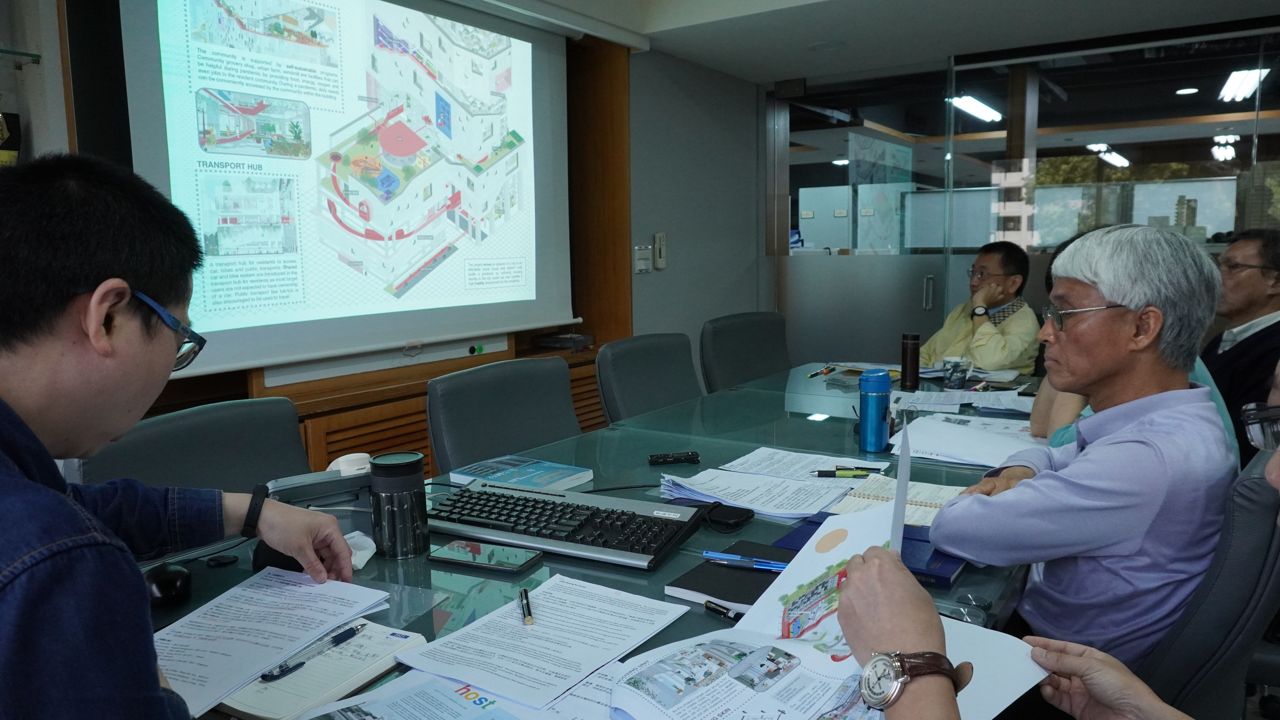
Solutions for pandemic
In general, solutions for pandemic prevention raised by 8 teams follow the basic demands such as good ventilation, sufficient daylight, enough public spaces. Design of farms, trading centers and working studios are also taken into consideration for a self-sufficient community in a lockdown situation caused by pandemic. However, creative ideas for housing layout to prevent pandemic is few. If the housing layout is put in the concept of pandemic prevention, units of housing will actively isolate the outbreak of pandemic to avoid the lockdown areas sweeping around communities and cities. The social cost will be reduced significantly.
In addition, the connection between housing and city is discussed less in their designs but the relationship between pandemic prevention and city is close. China, for example, uses the microdistrict (note 2) as an unit for management. The microdistrict will be blocked during the period of pandemic through the original settlement of entrance. However, how can we deal with the situation in countries such as Taiwan and others without the microdistrict, or the problem of transportation for traffic and living materials? Unfortunately, solutions for such the large-scale problems do not be discussed in designs of the competition.
Note 1:“Snake and Ladders” is an ancient Indian board game with 100 grids on game board. Players move by throwing a dice. Payers can move upwards when running into ladders but should moving backwards to the tail of snake when being bit by snake head. The player will win the game as long as moving to the grid marked 100.
Note 2: Microdistrict is a block of a range of residence with a relatively independent living environment in a specific area. Each microdistrict is often managed by a security company under contract and separated from other residential blocks or microdistricts by walls. The microdistrict has an independent entrance secured and often has a committee of owners.
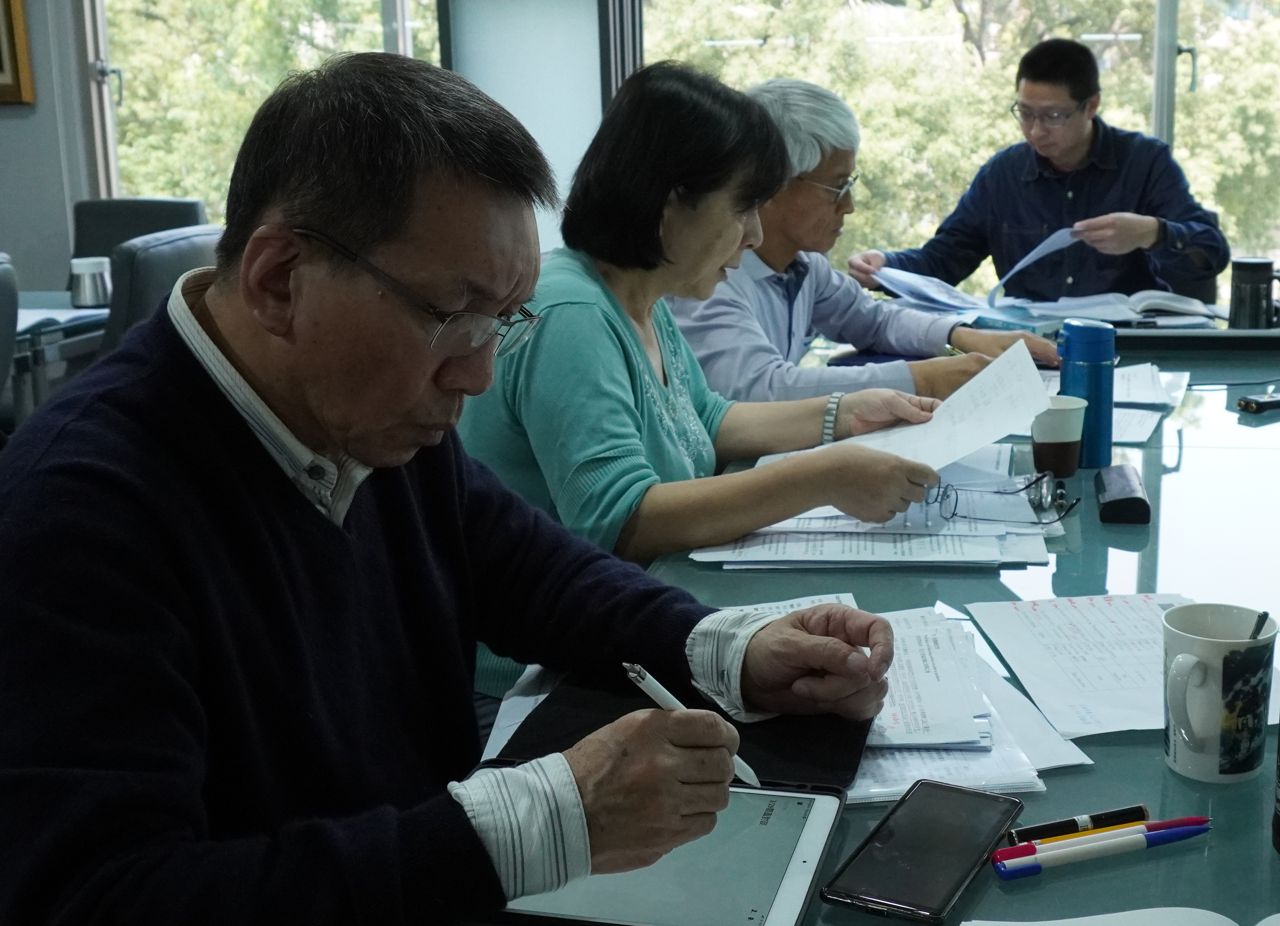
【Related reports】
>Inspiration from the Architectural Concept Design Competition of “The Future of Housing”/Chen, Chung-Heng
https://en.traa.com.tw/Event/News/190
>A Reflect on a New Living Model from the Pandemic of COVID-19/Huang, Chang-Mei
https://en.traa.com.tw/Event/News/188
>The future of housing/Francine Houben
https://en.traa.com.tw/Event/News/186
>「2021 International Residential Architecture Conceptual Design Competition」Winners Announced
https://en.traa.com.tw/Event/News/182
>「2021 International Residential Architecture Conceptual Design Competition」is launched!
https://en.traa.com.tw/Event/News/135
>2019 IRACC Awards Announcement
https://en.traa.com.tw/Event/News/141
